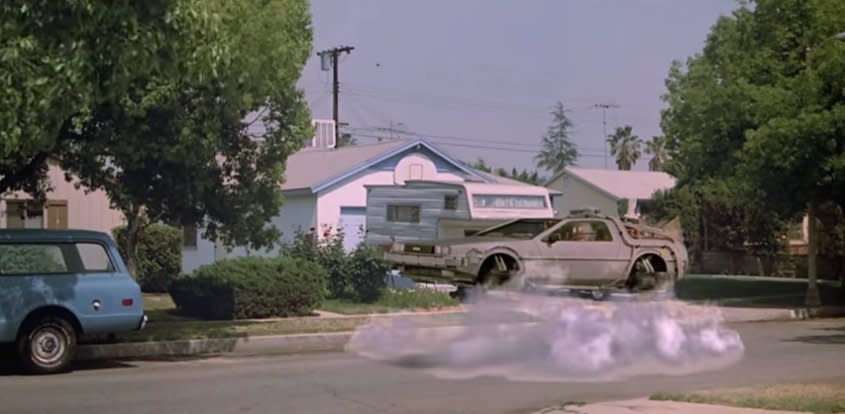Uber just unveiled its ambitious flying taxi plan — but it will have a lot of competition

The flying car in “Back to the Future.”
Uber just revealed new details about its flying taxi project.
At a Tuesday conference in Dallas, Uber revealed it will demo the futuristic transport system in 2020 with the help of partners like Embraer and Aurora Flight Sciences. It’s not the first time Uber has announced its intention to enter the realm of science fiction; the ride-hailing service released a white paper for its Uber Elevate plan in late October.
Uber, along with most companies in the space, aren’t releasing the flying cars you saw in “Back to the Future.” Rather, the majority are pursuing electric, vertical take-off and landing (VTOL) aircrafts for shorter urban commutes.
Like the name suggests, these are vehicles that can take off without needing a runway.
But competition is mounting when it comes to the flying-car moonshot — here are 6 companies working on their own flying taxi projects:
Read more:
1. Uber’s announcement comes just one day after Kitty Hawk, a project backed by Google co-founder Larry Page, took the wraps off its VTOL aircraft. The fully electric aircraft can only fly over water.

The Kitty Hawk Flyer weighs 220 pounds and relies on 8 rotors to fly. The startup is offering a $2,000 discount to those who pay $100 now to get on the wait-list, but a final price for the vehicle has yet to be released.

The vehicle can travel a maximum of 15 feet above the water at 25 mph. Kitty Hawk’s CEO is Sebastian Thrun, the founder of Google’s self-driving-car project and cofounder of Udacity.

Page has invested $100 million in Kitty Hawk and its other division, Zee.Aero, according to Bloomberg. A prototype of Zee.Aero’s aircraft was spotted in the wild in October.
2. German company eVolo made a big announcement in early April when it said it will use its VTOL aircraft for a pilot taxi service in 2018.

Source: Business Insider
Called the Volocopter 2X, the aircraft has 18 rotors and can fit two people.

The VTOL is powered by six batteries, allowing for just 17 minutes of flight. It can re-charge in 40 minutes using a fast charger.

3. Airbus is developing a single-person VTOL under its Silicon Valley arm A³ as part of its Project Vahana. The aircraft will be autonomous and can carry a single passenger or cargo.

A³ CEO Rodin Lyasoff said in a Medium post that it will fly a full-size prototype before the end of 2017. Zach Lovering, who oversees Project Vahana, told Business Insider that the group plans to have a production version ready by 2020.
The electric aircraft will have 8 rotors and will be able to achieve an altitude of about 1,000 feet. It will be fully self-piloted, though it will also come with autonomous tech like radar and lidar to detect obstacles.

You can read more about the project here.
Airbus is also designing a flying taxi system, named CityAirbus, that would have multiple propellers and resemble a small drone. Multiple people would be able to book a ride on the flying taxi system via an app.

Airbus wrote on its website that the CityAirbus taxi would first be operated by a pilot, but that a fully autonomous version would be released once regulations are in place.
4. Chinese drone company EHang plans to begin operating its flying taxi drone in July. It can carry 220 pounds, cruise at 62 mph, and fly over 11,000 feet.

Source: New York Times
EHang is building an Uber-like system that would allow passengers to enter their desired location. The drone would then autonomously fly to that given location.

5. Terrafugia is building a car that can take off, fly, and land autonomously — but you would still have to drive it manually.

The plug-in hybrid has a range of 500 miles, and it can take off vertically so you don’t need to be on a runway for liftoff.

Passengers can simply enter their desired location and it will fly on its own. The company has said a production version will be ready by 2025.

Terrafugia already sells its Transition flying car, which needs a runway to take off but can drive on roads. You need a Sports Pilot License to operate the vehicle.
6. Slovakian firm AeroMobil is accepting pre-orders for its $1 million flying car. Like Terrafugia’s Transition, AeroMobil’s vehicle is not a VTOL and needs a runway to take off.

The vehicle can transform into flight mode in just three minutes and cruise in the air at a top speed of 223 mph. AeroMobil is only making 500 units of the vehicle, which is rolling out to buyers in 2020.

As a car, the AeroMobil can reach a top speed of 100 mph. You need a Sports Pilot License to use the vehicle, which is only certified to operate in Europe.

The post Uber just unveiled its ambitious flying taxi plan — but it will have a lot of competition appeared first on Business Insider.

 Yahoo Finance
Yahoo Finance 
